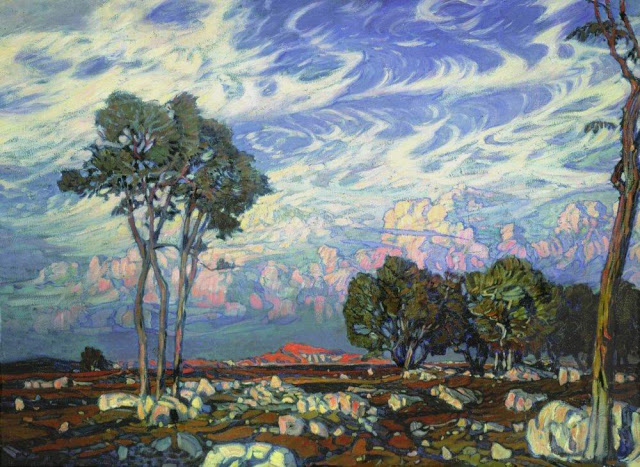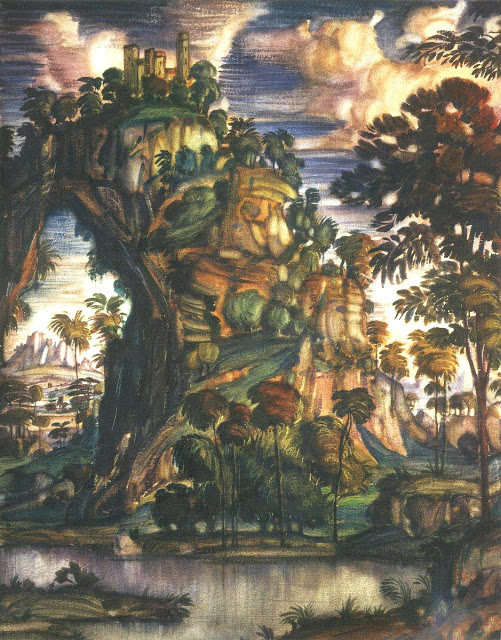Konstantin Fyodorovich Bogaevsky (Константин Фёдорович Богаевский),
January 1872- February 1943
Born in the Crimean port city of Theodosia (Feodosiya, now Ukraine), Bogaevsky began his career as an artist studying under the famous Russian/Armenian painter Ivan Aivazovsky. Widely known for his highly detailed seascapes and imaginative use of light, Aivazovsky instilled an interest in landscape painting early on and in 1891 Konstantin was accepted at the Imperial Academy of Arts in St. Petersburg. There he came under the tutelage of Arkhip Kuindzhi, whose style was also influenced by Aivazovsky: but Kuindzhi had a solid working class background and frequently fell out with the academics (he was fired from the academy in 1897 for support of student’s protests). Bogaevsky apparently shared at least some of his mentor’s philosophies, and was himself discharged from the Academy for a “lack of talent”.
 |
| Last Beams, 1903 |
 |
| The Genoa Fortress, 1907 |
 |
| Southern Country Cave, 1908 |
After St. Petersburg Bogaevsky traveled across Europe, studying the styles and direction of contemporary art. The majority of his early work had been classical Crimean landscapes influenced by the more traditional Renaissance painters such as Durer and Mantegna, but while in Italy and France he became acquainted with works of Claude Lorrain, whom he proclaimed as his true teacher.
 |
| Memoirs of Mantenie, 1910 |
 |
| Mountain St.Georgia, 1911 |
 |
| Evening Sun, 1912 |
|
|
 |
| Landscape with the Lock, 1912 |
His first exhibition took place in Moscow in 1898, but by 1900 he had returned to Theodosia and adopted a symbolist style which he continued to apply to landscape painting. The main theme of his works became a fictional land known to his friends as “Bogaevia” that he claimed to see in his dreams. Bogaevsky gained significant popularity after Maximilian Voloshin published a series of essays highly praising the symbolism of his work. In 1906 he exhibited his paintings in the Paris Exposition de l`Art Russe organized by Sergei Diaghilev, and was active with Diaghilev’s magazine Mir iskusstva as well as the Union of Russian Artists.
 |
| Cloud, 1920’s |
 |
| The Crimean Landscape, 1930 |
 |
| Old Harbour, 1931 |
In 1912 Bogaevsky befriended novelist and writer Alexander Grin, and became a regular in the Koktebel
group of Intelligentsia which included Maximilian Voloshin, Marina Tsvetaeva and
Osip Mandelstam. After the 1917 October Revolution
Bogaevsky fell into obscurity, although the Soviets never prosecuted
him: his 1932 painting “Port of an Imaginable City” was even praised
as Socialist Realism painting of the DnieproGES.
 |
| Mountain Landscape, 1940 |
 |
| Mountain Landscape, early 1940’s |
Konstantin Bogaevsky was killed in Theodosia during an Allied bombing raid on February 17, 1943.
References:















Comments
Konstantin Bogaevsky, Crimean Landscapes — No Comments
HTML tags allowed in your comment: <a href="" title=""> <abbr title=""> <acronym title=""> <b> <blockquote cite=""> <cite> <code> <del datetime=""> <em> <i> <q cite=""> <s> <strike> <strong>